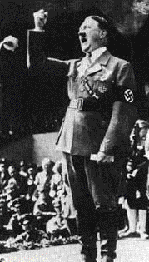
Introduction
-Intro
-semiotics
-denotation & connotation
-light & the
mechanics of vision
-the basic visual elements
-montage & Mise-en-Scene
The swastika, for example, is a symbol made of a series of lines which resemble the convergence of 4 "Ls". This explanation reflects the denotative level. The swastika is also a symbol that represents the terror of Nazi Germany's Third Reich. This explanation operates at what is called the connotative level.

Denotation - Saussure's system of signification is essentially
denotative. It offers a particular meaning given by the sign that is obvious.
ex.
train ( P ) Pronunciation
Key (trn) n.
1. A series of connected railroad cars pulled or pushed by
one or more locomotives.
2. A long line of moving people, animals, or vehicles.
3. The personnel, vehicles, and equipment following and providing supplies
and services to a combat unit.
4. A part of a gown that trails behind the wearer.
5. A staff of people following in attendance; a retinue.
6. a. An orderly succession of related events or thoughts; a sequence. See
Synonyms at series.
b. A series of consequences wrought by an event; aftermath.
7. A set of linked mechanical parts: a train of gears.
8. A string of gunpowder that acts as a fuse for exploding a charge.
Connotation - Meanings that are suggestive or based on associations
outside the systems of signs.
ex. A fast moving train can be associated with progress
in advertising. We have culturally built that association.
Roland Barthes (1915-80) pronounced BART
Barthes uses the theories of semiotics to show how the denotations in the signs of popular culture betray connotations that are generated by the larger sign system that makes up society.
Barthes work explored the connotations of signs (external to sign associations) at play in culture.
"Speech of this kind is a message. It is therefore by no means confined
to oral speech. It can consist of modes of writing or of representations; not
only written discourse but also photography, cinema, reporting, sports, shows,
publicity, all these can serve as a support to mythical speech."
---Roland Barthes, Mythologies, 1972
A photograph is a kind of speech in that it tries to signify or communicate a message. The message depends on how it fits into the larger system.
A symbol (signifier) vary in meaning (interpretation) depending on context.
ex. Pentacle shape. The Pentacle or five pointed star is preeminent. It
is the basis of Phi-lo-Sophia (Philosophy), and is one of the more common, simple
motifs in the modern world -- ranging from star(s) on a national flag to Corporate
logos (e.g. Texaco) to the designation of many Hollywood celebrities. Based on
it's context, or surrounding symbols, it can change meaning.
| Penelope’s | Pentacle | Flower | Ringed Pentacle | Star | Star of the Muses |
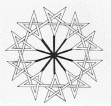 |
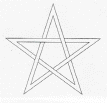 |
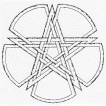 |
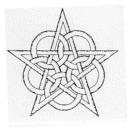 |
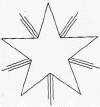 |
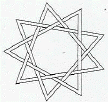 |
 =
witchcraft
=
witchcraft
 = texaco
= texaco